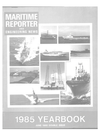
Page 87: of Maritime Reporter Magazine (June 1985)
Read this page in Pdf, Flash or Html5 edition of June 1985 Maritime Reporter Magazine
its shipbuilding dollars. Navy Secre- tary Lehman does his homework well, and he is a hard bargainer. He almost always gets what he asks for from Congress, but then turns around and insists on getting from the private sector full value, and then some, for every shipbuilding or aircraft procurement dollar spent.
He is wedded to the concept of com- petition, and has used it to drive down prices. He is also a bargain- hunter, willing to buy no-longer- competitive merchant ships, wheth- er U.S.-built or foreign-built (the
Sea-Land SL-7s are a particularly good example), for conversion, mod- ernization, and subsequent assign- ment to either the active fleet or the Military Sealift Command's re- invigorated Ready Reserve Force (RRF).
A second caveat is that Pentagon procurement practices overall have been in a state of flux in recent years, with much greater emphasis on serious production and multi- year and multi-unit procurement.
The net effect from the contractor's point of view is better long-term security and a potentially higher profit margin, but at the same time a higher element of risk involving difficult-to-absorb losses if actual costs exceed estimated costs.
Yet a third caveat, perhaps the most important insofar as the U.S. shipbuilding community is con- cerned, is that the Reagan/Wein- berger/Lehman buildup to a 600- ship fleet is predicated largely on: (1) Conversions of ships already in the inventory (SLEP means service- life extension program); (2) Reacti- vation of older ships, such as the
Iowa-class battleships; and (3) In- creases in the building rate of ships proposed earlier in the Carter SCN program—e.g., SSN-688 (Los An- geles-class I) nuclear attack subma- rines, and the Ticonderoga-class
Aegis guided missile cruisers.
In that context, the start of the
DDG-51 Arleigh Burke construction program takes on special signifi- cance. With Newport News Ship- building locked in as prime contrac- tor on all new aircraft carriers, and with Newport News and the Electric
Boat Division of General Dynamics sharing the submarine programs be- tween them (not necessarily on a SO-
SO basis, though), the DDG-51s rep- resented by far the biggest new-con- struction opportunity open to vir- tually all bidders. Added to that huge economic incentive are a num- ber of other factors, including the following: (1) Although present Navy plans project construction of only 29
Burkes—at a total program cost of $20-30 billion—earlier projections were based on a total program rang- ing from 49 ships (the number pro- posed by the Carter Administra- tion) to 63 ships (the number earlier used by Reagan Administration wit- nesses before Congress, and still used by Congressional Budget Of- fice staffers in their "most likely" scenarios developed for long-term budget planning.) (2) The lead-ship award to BIW doesn't end the competition; it only ends Round One. The Navy plans to
Circle 167 on Reader Service Card •>• bring a second yard into the produc- tion program in 1987, and possibly a third yard a year or two later. There are several reasons for this ap- proach: to spread the work around, and keep more yards economically viable; to get more ships into the active fleet at an earlier date; and to keep the competition alive—and, thus, to keep costs low—for the entire life of the program. (3) The continuing drive for sys- tems "commonality" and for use of "off the shelf" technology and com- ponents in new-ship construction makes it almost inevitable that those yards, suppliers, and subcon- tractors that win a piece of the Aegis action will have a leg up in the bid- ding for future contract awards, whether new-construction or repair/ renovation/modernization.
One general observation, before looking at some of the more impor- tant specifics of the DDG-51 design and its various hardware and pro- pulsion systems: Although the Ar- leigh Burke will be, like its illus- trious destroyer predecessors, a nav- al jack-of-all-trades (and master of most), it will be as unlike the fabled "tin can" of the WWII years as today's "Right Stuff" astronauts are from the aerial barnstormers of the between-wars era. The machismo is (continued on page 86) •r« -i
J ' F- ' ' •». • •• ' » f • ' -— if., . v / y * * - -> : •HEHBU •• • i ,. -J J- * ' •* t i i > ^^^ t, % *P -V <1 i
V —-v " x I
I; , • Af •< f I
PROVEN QUALITY & RELIABILITY ...OPTIMUM PRICING & DELIVERY! • SALTWATER SHIPS and TUG/BARGES to 760'. • GREAT LAKES SHIPS to 1,100'. • LARGE GRAVING DOCK...1,158' long with a travel- ing gantry crane capable of handling up to 200-ton super-sections, fabricated simultaneously at numer- ous adjacent locations. • COMPLETE IN-HOUSE CAPABILITIES... to design, engineer, build, repair, convert, re-power, retrofit and jumboize. • BUILDING SHIPS SINCE 1902 ... an established company with modern facilities, including computer lofting and burning.
Bay Shipbuilding Corp. has built more modern self- unloading vessels than any other shipyard in the
United States. In addition, many other vessels have been converted to self-unloaders.
Our Company's 80-plus years of expertise is the pri- mary reason we routinely deliver on schedule.
Our personnel have experience in coal and oil-fired steam propulsion and diesel ships. Our experience also includes the construction of commercial ocean tankers/barges and chemical carriers, dump barges, derrick ships, passenger ships, tug/barge units includ- ing self-unloading barges, stern trawlers, and indus- trial products.
WE'RE READY TO SERVE YOU...
BAY SHIPBUILDING CORP.
Subsidiary of The Manitowoc Company, Inc. 605 North 3rd Avenue, Sturgeon Bay, Wl 54235
Phone: 414-743-5524/Telex: 263448 MTWC ENG MATC
Twx: 910-260-3500 MTWOC ENGR ©BAY SHIPBUILDING CORP. 1984

 86
86

 88
88
